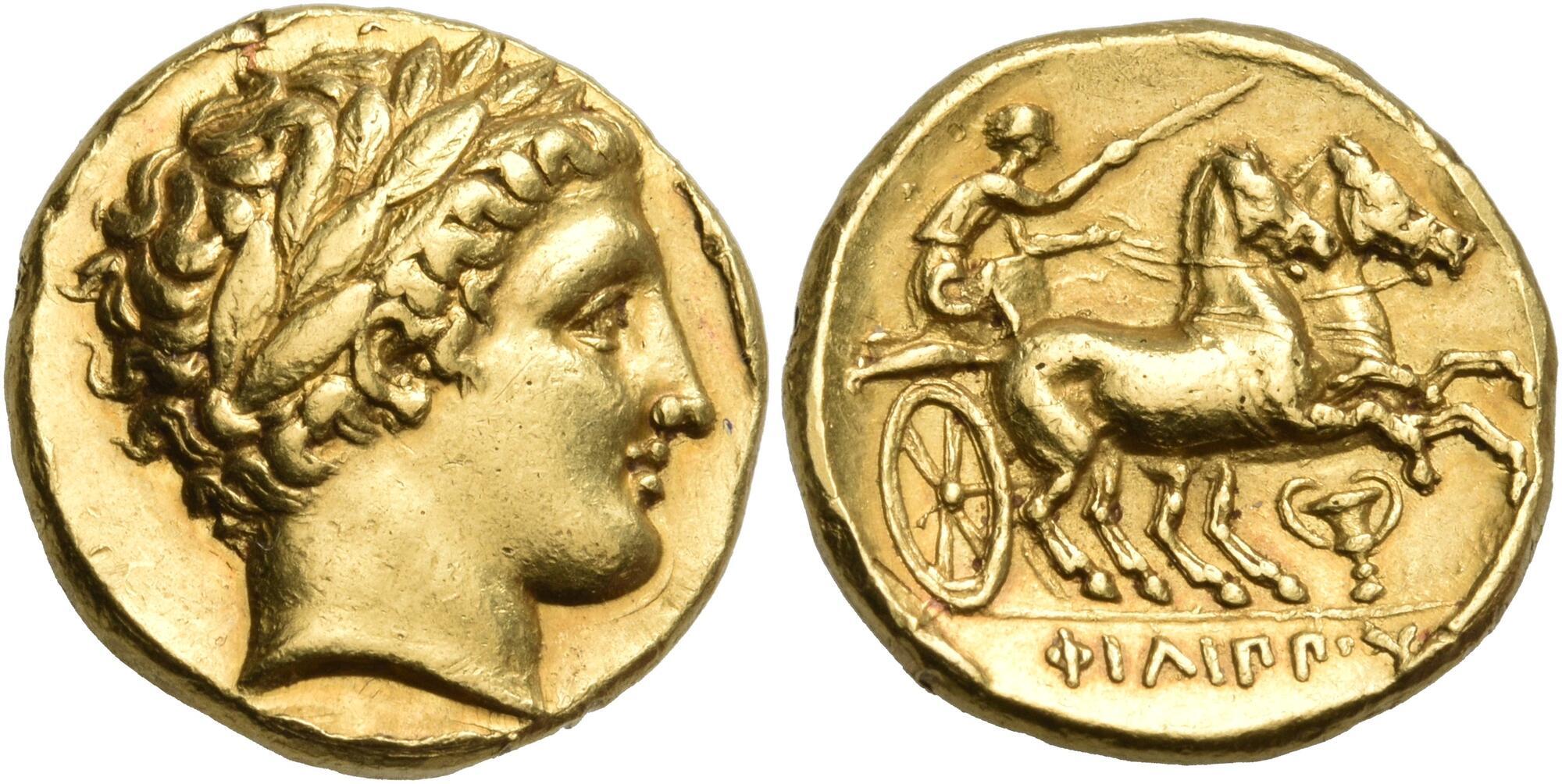H 94 - Pella, Group I (Philip II), gold, staters (342-336 BCE)
From SILVER
(Redirected from RQEMH 94 - Pella (Macedonia), gold, stater, 345-310 BC)
342 BCE - 336 BCE Gold 57,011 kg
Description
| ObverseInscription or printing placed on the obverse.: | Laureate head of Apollo to right |
| ReverseInscription or printing placed on the reverse.: | ΦΙΛΙΠΠΟΥ (Greek).Charioteer driving chariot drawn by two rearing horses to right, holding reins in his left hand and goad in his right |
Mint and issuing power
| MintIdentifies the place of manufacture or issue of a numismatic object.: | Pella | Ancient regionAncient region.: | Macedon | Modern countryModern country: Greece | AuthorityIdentifies the issuing power. The authority can be "pretended" when the name or the portrait of X is on the coin but he/she was not the issuing power. It can also be "uncertain" when there is no mention of X on the coin but he/she was the issuing power according to the historical sources: | Philip II (Argead king, 359-336 BC) |
Chronology
| FromIdentifies the initial date in a range assigned in a numismatic context. | 342 BCE | toIdentifies the final date in a range assigned in a numismatic context.. | 336 BCE | PeriodTime period of the numismatic object.: Classical 480-323 BC |
Physical description
| MetalThe physical material (usually metal) from which an object is made.: | Gold |
Median weightMedian of the weights of numismatic objects (in grams). in grams | 8.55 | DenominationTerm indicating the value of a numismatic object. Examples: tetradrachm, chalkous, denarius.: | stater |
StandardStandard.: | Attic |
Image

RQEMH 94 - Pella (Macedonia), gold, stater, 345-310 BC.jpg [1]
References
| Die study referencePublication of the study: | Le Rider 19771Le Rider 1977 | ||
| Coin series referenceReference to coin series study: | RQEMH2RQEMH, n° 94 | ||
Obverse dies distribution
| FrequencyFrequency of specimen in distribution. ᵖ | Number of obversesNumber of obverse dies. ᵖ (o) | % (o) | Number of coinsNumber of coins. (n) | % (n) | Die nameName(s) of the die(s). |
| 1 | 6 | 21.43 | 6 | 5.83 | 5, 11, 18, 24, 25, 26 |
| 2 | 5 | 17.86 | 10 | 9.71 | 2, 7, 13, 15, 22 |
| 3 | 6 | 21.43 | 18 | 17.48 | 1, 12, 14, 16, 20, 21 |
| 4 | 3 | 10.71 | 12 | 11.65 | 3, 4, 23 |
| 5 | 3 | 10.71 | 15 | 14.56 | 6, 17, 19 |
| 6 | 1 | 3.57 | 6 | 5.83 | 10 |
| 8 | 2 | 7.14 | 16 | 15.53 | 8, 9 |
| 10 | 2 | 7.14 | 20 | 19.42 | 27, 28 |
| Total | 28 of 28 | 99.99 | 103 of 103 | 100.01 |
Reverse dies distribution
no distribution is available
Quantification
| Number of obversesNumber of obverse dies. ᵖ (o) | 28 | Number of singletons (o1)The number of singleton coins. ᵖ | 6 |
| Number of reverse diesNumber of reverse dies. (r) | 48 | Number of coinsNumber of coins. (n) | 103 |
| Coins per obverse dieNumber of coins per obverse die. (n/o) | 3.68 | Coins per reverse dieNumber of coins per reverse die. (n/r) | 2.15 |
| Reverse per obverse ratioRatio of obverse dies divided by reverse dies. (r/o) | 1.71 | Percentage of singletons (o1)number of coins (n) divided by the number of singletons (o1) ᵖ | 21.43 % |
| Original number of dies (O) (Carter 1983 formula)The estimation of the number of coins according to Carter 1983 ᵖ | 33.34 | Coins struck if 20,000 as average productivity per dieCoins made if the average productivity for obverses (according to Carter) is 20,000. ᵖ | 666,800 |
| Original number of dies (O) (Esty 2011 formula)The estimation of the number of coins according to the singleton formula in Esty 2011 ᵖ (O) | 38.45 | Survival rate if 20,000 as average productivity per dieSurvival rate if average productivity is 20,000. ᵖ | 0.00015 |
| Coverage (o = % of O) (Esty 1984 formula)Esty 1984 - coverage (% of O) ᵖ (o = % of O) | 94.17% | Die productivity if survival rate 1/2,000Average productivity if survival rate is 1/2,000. ᵖ | 6,178.76 |
| Weight of silver (in kg) if 20,000 coins per die (O = Carter formula)Carter 1983 * Median weight * 20000 (*10 if gold or electrum) ᵖ | 57,011 kg <br /> 57,011 kg | Die productivity if survival rate 1/5,000Average productivity if survival rate is 1/5,000. ᵖ | 15,446.91 |
Remarks